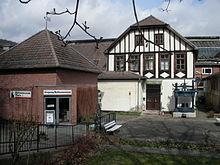Thale Hut Museum
The Thale Hüttenmuseum was founded in 1986 for the 300th anniversary of the Thale ironworks . Since July 1, 1998, the museum has been sponsored by the History and Hüttenmuseumsverein Thale am Harz eV It shows the development of iron smelting and iron processing using the example of the Thalenser factory from the tin works in 1686 to the large industrial enterprise of the 20th century.
location
The museum is located at the entrance to the Bodetal, about three minutes from Thale's main train station. The museum is located at Walter-Rathenau-Straße 1 in the former residential building of the hut owner Johann Carl Benninghausen and was brought into its present form through renovations. To the west of the entrance is the Thale hut chapel , which is used as a museum gallery .
exhibition
The museum shows the historical and social development of the company and its employees from 1686 to the recent past. Particularly noteworthy are the processes of smelting and subsequent processing of the iron, which are illustrated using models such as the racing furnace, high furnace and fresh fire.
Special historical aspects and moments of the Thale iron and steel works are highlighted here. For example, the following points should be mentioned here: In 1831 Germany's first wrought-iron wagon axle was manufactured in Thale. In 1835, the first enamelling plant in Europe was built, which around 1910 produced ten percent of the world's enamel dishes. The industrial revolution can be illustrated by several points: the railway connection in the direction of Quedlinburg, Magdeburg and Berlin in 1862, the use of the first steam engines in 1868 and the establishment of the stock corporation in 1872. This led to rapid growth in the plant and the number of employees at the Thale site. As a result of industrialization , Thale was granted city rights in 1922.
The main branches of production were after the Second World War, in which the plant suffered no war damage, although from 1934 a monopoly on steel helmets had the steel mill , the mill , the enamelling , the tank and apparatus (from the company in 2007 THALETEC emerged ) and powder metallurgy . One of the main shareholders of the plant was the Cologne entrepreneur Albert Ottenheimer until 1937 . His participation then came to the Otto Wolff Group through forced Aryanization .
Since 1995, concrete environmental history has also been shown. Here the interrelationships between the growth of the ironworks and the town of Thale as well as the handling of the pollution for people, air, water and soil through over 300 years of metallurgical production are illustrated. Since the year 2000 there has been a further part of the exhibition that deals with the removal of industrial pollution.
Since 1998 there have been several loans from the artist Willi Neubert in the foyer of the museum , which come from his artistic work closely connected to the ironworks. In 2005, the wall enamel picture "300 years of ironworks", which was saved and stored from the demolition of the apprentice dormitory in 2001, was mounted on the steam engine building, thus making a memorial at the memorial accessible to the public again.
In addition to the permanent exhibition, there are special exhibitions that change several times a year, ranging from painting and sculpture to the history of technology.
Steam engine
Another special feature is the steam engine from 1911, which was in operation from 1912 until the block rolling mill was shut down in 1990. This was built by Ascherslebener Maschinenbau AG and is a double-acting tandem drum-type steam engine. After it was restored on behalf of the association and reactivated with the help of an engine, it has been in demonstration operation since May 2009.
Web links
Coordinates: 51 ° 44 ′ 40.9 ″ N , 11 ° 1 ′ 40 ″ E

